Universal Gravitation - Complete Toolkit
Objectives
- To be able to explain how Newton used the apple and the moon argument to introduce his idea of universal gravitation and it inverse square relationship with distance.
- To state the law of universal gravitation in word form and in equation form and to understand the meaning of the variables within the equation.
- To use the universal gravitation equation to make predictions of the effect of an alteration of mass or separation distance upon the amount of gravitational force.
- To understand how the universal gravitation equation can be combined with Fgrav = m•g to derive an equation for gravitational field strength (g = G•M/d2).
- To use the universal gravitation equation and the gravitational field strength equation to solve simple algebraic word problems.
Readings from The Physics Classroom Tutorial
- The Physics Classroom Tutorial, Circular Motion and Satellite Motion Chapter, Lesson 3
Interactive Simulations
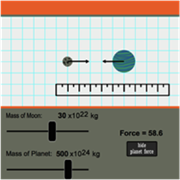 The Physics Interactives: Gravitation
The Physics Interactives: Gravitation
Field trips to other planets in the solar system to study gravitation do not seem to get approved by school administrators. But with this Interactive, who would need a field trip? Students can vary the mass of a planet, the mass of its moon, and the separation distance between them and view the force of gravitational attraction. The Interactive makes for a great study of how one variable affects another variable. An activity sheet is provided to assist in this effort. The Interactive works well on Chromebooks, iPads, and mobile phones, making it a great addition to a 1:1 classroom.
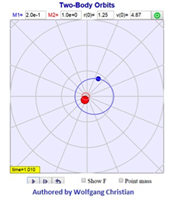 Open Source Physics: Two-Body Orbits
Open Source Physics: Two-Body Orbits
This classroom-tested model has been rewritten to HTML – this version is great for beginning learners. It represents a moon-planet system interacting via Newton’s Law of Universal Gravitation. You can set mass for each interacting object, change the radius, and set the velocity.
Teachers: If you have a Java-enabled computer lab, you might want to try the Java version of this simulation, which offers more tools and a 3D view. Follow this link: http://www.opensourcephysics.org/items/detail.cfm?ID=12222
 The Physics Interactives: Your Weight on Other Planets
The Physics Interactives: Your Weight on Other Planets
Not happy with the scale reading these days? Perhaps you would like it better on another planet. Take a quick trip to some other planets and hop on their scales to see if it looks any better. This phun interactive is bound to teach you about other planets and about how your weight varies with location in the solar system. Each screen of this Interactive features a different planet, providing a NASA photo of the planet, the planet mass and radius, the weight of a 50-kg person on the planet, and some intriguing facts about the planet. The Interactive works well on Chromebooks and iPads, making it a great tool for a 1:1 classroom. Lots of student appeal.
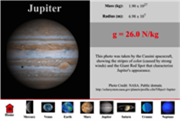 The Physics Interactives: The Value of g on Other Planets
The Physics Interactives: The Value of g on Other Planets
If your students enjoyed the Your Weight on Other Planets Interactive (above), they will also enjoy this Interactive. Each screen includes a NASA photo, the mass and radius of the planet, some intriguing facts about the planet, and the value of the gravitational field strength upon that planet. Chromebook- and iPad-friendly
Video and Animations
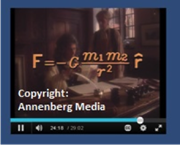 The Mechanical Universe and Beyond: The Apple and the Moon
The Mechanical Universe and Beyond: The Apple and the Moon
Episode 8 of the respected Mechanical Universe series explores how Sir Isaac Newton built on the work of Galileo and Copernicus to construct theories about gravity and derive the calculations that underlie universal gravitation. Why we like it: Annenberg Media does a great job of integrating history, physics, and mathematics in a way that sheds light on the people behind the science. The video would be a good choice as a flipped lesson or for students with reading disabilities.
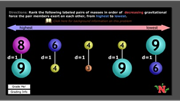 University of Nebraska Astrophysics Interactives
University of Nebraska Astrophysics Interactives
This set of six HTML interactive activities, developed by the well-regarded Nebraska Astronomy Applet Project, provides practice in applying Newton’s Law of Universal Gravitation to rank greatest-to-least. Teachers: If you haven’t tried ranking tasks in your classes, you’ll love them.
Task 1: http://astro.unl.edu/interactives/gravity/ForceOfGravity1.html
Task 2: http://astro.unl.edu/interactives/gravity/ForceOfGravity2.html
Task 3: http://astro.unl.edu/interactives/gravity/ForceOfGravity3A.html
Task 4: http://astro.unl.edu/interactives/gravity/ForceOfGravity3B.html
Task 5: http://astro.unl.edu/interactives/gravity/ForceOfGravity3C.html
Task 6: http://astro.unl.edu/interactives/gravity/ForceOfGravity3D.html
 Veritasium: Why Are Astronauts Weightless?
Veritasium: Why Are Astronauts Weightless?
Physicist Derek Muller packs a lot of punch with this short video that debunks the myth that astronauts in the ISS are in a zero-gravity environment. As he explains, the space station orbits Earth at 400 km above the surface, so it is subject to the Law of Universal Gravitation (in other words, it is pulled toward Earth by gravity). The sensation of weightlessness is actually free fall! So why doesn’t the ISS crash into Earth? It’s traveling at an orbital velocity of 28,000 km/hr, so as it falls, the Earth curves away from it.
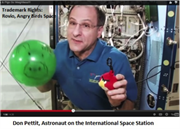 NASA: Angry Birds and Microgravity
NASA: Angry Birds and Microgravity
This resource combines informative text with a 4-minute video to explain the concept of microgravity, the force acting on the International Space Station and objects inside it (like astronauts). The fun comes when astronaut Don Pettit explains how the Angry Birds Space game can be applied to help you understand gravity and trajectory. This resource was the result of a collaboration between NASA and the creators of Angry Birds Space to create interactive educational experiences for the public.
Gravitation in a Historical Context
 BBC: Isaac Newton – The Man Who Discovered Gravity
BBC: Isaac Newton – The Man Who Discovered Gravity
Simply put, this is the most engaging and well-presented digital timeline we’ve seen on Isaac Newton. It blends text and video clips to introduce Newton the human being, not the icon……a troubled man with a difficult childhood and a penchant for alienating his peers. It takes you on a journey from Newton’s early life through the Plague years, authorship of Principia Mathematica, and culminates in his leadership of the Royal Academy. You’ll get a candid look at Newton’s personality, his strengths and flaws, and (of course) his genius.
 Weighing the Earth in 1798: The Cavendish Experiment
Weighing the Earth in 1798: The Cavendish Experiment
This paper by Stanford University student Virginia Chang takes a deep look at Henry Cavendish’s groundbreaking work to determine the density of the Earth by using a torsional spring system. By 1798, scientists were using Newton’s Universal Gravitation Law to predict motion of the planets, but Cavendish wanted to “render sensible the attraction of small quantities of matter”. This resource shows in great detail how Cavendish set up his experiment, how he did his measurements, and how he used the results to find the density of the Earth.
 The Cavendish Experiment as a Tool for Historical Understanding of Science
The Cavendish Experiment as a Tool for Historical Understanding of Science
What if your students could transport back in time to 1798? Would they be able to design an experiment to calculate the gravitational constant, working only with a mathematical framework based on proportions? Well….probably not. This article emphasizes the importance of historical context in the teaching of science. When Cavendish designed his torsional spring system, he never conceived of his experiment as a way to measure g! The author says, “The Cavendish Experiment is a paradigmatic case of how conclusions about the empirical world were obtained in the absence of equations.” This resource aligns well with NGSS Nature of Science standards.
- The Newton Project
 For teachers or students wanting a seriously deep dive into Sir Isaac Newton’s writings, this is the definitive resource for you. The Newton Project has published over 4 million words of text since 2008, providing annotated lists of every document published, along with translations and podcast interviews with historians. Three categories are covered: Newton’s Works, his Notebooks, and his Correspondence.
For teachers or students wanting a seriously deep dive into Sir Isaac Newton’s writings, this is the definitive resource for you. The Newton Project has published over 4 million words of text since 2008, providing annotated lists of every document published, along with translations and podcast interviews with historians. Three categories are covered: Newton’s Works, his Notebooks, and his Correspondence.
Labs and Investigations
- The Physics Classroom, The Laboratory, Solar System Sports Spreadsheet Study
This open-ended project involves the use of a spreadsheet to ponder a question regarding a projectile’s motion in another planet. Students design their own question (for instance, how high can Michael Jordan jump on the moon?) and use the spreadsheet to answer the question.
Link: http://www.physicsclassroom.com/lab#circ
Elsewhere on the Web
 The Torsion Balance Experiment
The Torsion Balance Experiment
Want to build a torsion balance system but can’t afford the $2,000 kits from science supply houses? This is for you…..this lab procedural was written by John Walker, one of the original authors of AutoCad. The page provides 3 labs, all about gravity. The one pertaining to this unit is the middle one titled “The Torsion Balance”. It shows you how to replicate the Cavendish experiment using a ladder, styrofoam, two fishing sinkers, a tuna can, and nylon monofilament string. The only significant expense is in the camera.
Note: There are 3 experiments on this web page. Scroll down to the middle.
- Understanding of Gravity, Gunstone and White, Science Education, Vol. 65, Issue 3, pp. 291-299.
If you invest in only one research article about gravity, we suggest you rent and read this article (available from Wiley Online Library for $6.00). It reports on a large-scale study that investigated understanding of gravity and related principles among first-year physics students in Australia. The authors’ conclusion: students know a lot of physics
 NOVA: All About G Forces
NOVA: All About G Forces
What’s behind g forces, and how much can the human body stand? This readable, informative article from NOVA takes a deep look at the phenomenon we call “g force” as it relates to acceleration of humans. You’ll get a glimpse of early (and dangerous) experiments that paved the way for our understanding of how magnitude and duration of g forces are as critical as direction of the force.
Educational Research
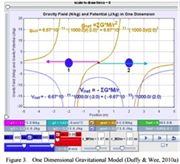 A New Educational Perspective for Teaching Gravity, Baldy, International Journal of Science Education, vol. 29, issue 14, pp. 1767-1788.
A New Educational Perspective for Teaching Gravity, Baldy, International Journal of Science Education, vol. 29, issue 14, pp. 1767-1788.
The author of this study uses experimental results to support a recommendation to teach about gravity from a new educational framework based on Einstein’s theory. The study results indicate that using Newton’s Law of Universal Gravitation to introduce gravity is ineffective and reinforces misconception. If you don’t have time to read the whole paper, you might want to read the introduction that lists common erroneous ideas about gravity among secondary students: i.e., “Gravity is not universal”, “Earth is a special case”, “Gravity is like a magnet”, “Gravity on Earth is different from gravity in space.” The experiment established two groups: one taught gravity within a Newtonian framework, and the other taught within an Einstein approach to gravity. Classes taught using the Einstein approach produced a significantly greater percentage of students able to generalize gravitational effects to the entire universe and to understand the value of g.
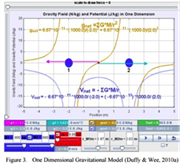 Enabling Gravity – Physics by Inquiry using Easy Java Simulation
Enabling Gravity – Physics by Inquiry using Easy Java Simulation
Pedagogical article discusses a pilot program in Singapore that uses four interactive computer models to teach concepts related to gravity, orbital motion, and gravitational field in the high school classroom. The program was designed to help students visualize gravitational field strength and how gravitational attraction is affected by mass and distance. All the models were developed based on computationally accurate values for velocity and mass. Student feedback was logged -- most reported a greater ease in understanding gravitation because they could "see" how it worked.
Demonstration Ideas
Minds On Physics Internet Modules:
The Minds On Physics Internet Modules are a collection of interactive questioning modules that target a student’s conceptual understanding. Each question is accompanied by detailed help that addresses the various components of the question.
- Circular Motion and Gravitation, Ass’t CG6 - Newton’s Law of Universal Gravitation
- Circular Motion and Gravitation, Ass’t CG7 - The Acceleration of Gravity
Concept Building Exercises:
- The Curriculum Corner, Circular Motion and Gravitation, Universal Gravitation
- The Curriculum Corner, Circular Motion and Gravitation, The Inverse Square Law
Problem-Solving Exercises:
- The Calculator Pad, Circular Motion and Gravitation, Problems #16-21
Link: http://www.physicsclassroom.com/calcpad/circgrav
Standards:
A. Next Generation Science Standards (NGSS)
Performance Expectations
- Forces and Motion HS-PS2-4: Use mathematical representations of Newton’s Law of Gravitation to describe and predict the gravitational forces between objects.
Disciplinary Core Ideas
- Forces and Motion-Types of Interactions - HS-PS2.B.i: Newton’s Law of Universal Gravitation and Coulomb’s Law provide the mathematical models to describe and predict the effects of gravitational and electrostatic forces between objects.
- Forces and Motion-Types of Interactions - PS2.B.ii: Forces at a distance are explained by fields (gravitational, electric, and magnetic) permeating space that can transfer energy through space. Magnets or electric currents cause magnetic fields; electric charges or changing magnetic fields cause electric fields.
Crosscutting Concepts
Scale, Proportion, and Quantity
- High School: The significance of a phenomenon is dependent on the scale, proportion, and quantity at which it occurs.
Systems and System Models
- High School: When investigating or describing a system, the boundaries and initial conditions of the system need to be defined and their inputs and outputs analyzed and described using models.
- High School: Models can be used to predict the behavior of a system, but these predictions have limited precision and reliability due to the assumptions and approximations inherent in models.
Science and Engineering Practices
Practice #1:
- High School: Analyze data using tools, technologies, and/or models (e.g., computational, mathematical) in order to make valid and reliable scientific claims
Practice #2: Developing and Using Models
- High School: Develop and use a model based on evidence to illustrate the relationships between systems or between components of a system. (Strong alignment)
- High School: Use a model to provide mechanistic accounts of phenomena. (Strong alignment)
Practice #3: Planning and Carrying Out Investigations
- High School: Plan and conduct an investigation individually and collaboratively to produce data to serve as the basis for evidence
Practice #5: Using Mathematics and Computational Thinking
- High School: Create or revise a computational model or simulation of a phenomenon, process, or system. (Strong alignment)
- High School: Use mathematical representations of phenomena or design solutions to describe and/or support claims and/or explanations. (Strong alignment)
The Nature of Science: Order & Consistency in Natural Systems
- High School: Scientific knowledge is based on the assumption that natural laws operate today as they did in the past and they will continue to do so in the future.
- High School: Science assumes the universe is a vast single system in which basic laws are consistent.
- High School: Science assumes that objects and events in natural systems occur in consistent patterns that are understandable through measurement and observation.
B. Common Core Standards for Mathematics – Grades 9-12
Standards for Mathematical Practice:
- Reason abstractly and quantitatively
- Model with mathematics
- Make sense of problems and persevere in solving them
Quantities
- High School N-Q.1: Use units as a way to understand problems and to guide the solution of multi-step problems; choose and interpret units consistently in formulas; choose and interpret the scale and the origin in graphs and data displays.
Algebra
- High School A-SSE.1. Interpret parts of an expression, such as terms, factors, and coefficients.
- High School A-SSE.2 Use the structure of an expression to identify ways to rewrite it.
- High School A-CED.2 Create equations in two or more variables to represent relationships between quantities
- High School A-CED.4 Rearrange formulas to highlight a quantity of interest, using the same reasoning as in solving equations.
Functions
- High School F-IF.4 For a function that models a relationship between two quantities, interpret key features of graphs and tables in terms of the quantities, and sketch graphs showing key features given a verbal description of the relationship.
- High School F-IF.6 Calculate and interpret the average rate of change of a function (presented symbolically or as a table) over a specified interval. Estimate the rate of change from a graph.
Linear, Quadratic, and Exponential Models
- High School F-LE.1.b Recognize situations in which one quantity changes at a constant rate per unit interval relative to another.
- High School F-LE.5 Interpret the parameters in a linear or exponential function in terms of a context.
C. Common Core Standards for English/Language Arts (ELA) – Grades 9-12
Reading Standards: Literacy in Science and Technical Subjects– Key Ideas & Details
- High School RST11-12.3 Follow precisely a complex multistep procedure when taking measurements or performing technical tasks; analyze the specific results based on explanations in the text.
- High School RST.11-12.2 Determine the central ideas or conclusions of a text; summarize complex concepts, processes, or information presented in a text by paraphrasing them in simpler but still accurate terms.
Reading Standards: Literacy in Science and Technical Subjects – Integration of Knowledge and Ideas
- High School RST.11-12.7 Integrate and evaluate multiple sources of information presented in diverse formats and media (e.g., quantitative data, video, multimedia) in order to address a question or solve a problem.
- High School RST.11-12.9 Synthesize information from a range of sources (e.g. texts, experiments, simulations) into a coherent understanding of a process, phenomenon, or concept.
Reading Standards: Literacy in Science and Technical Subjects – Range of Reading and Level of Text Complexity
- High School RST.11-12.10 By the end of Grade 10, read and comprehend science/technical texts in the Grade 9-10 text complexity band independently and proficiently.